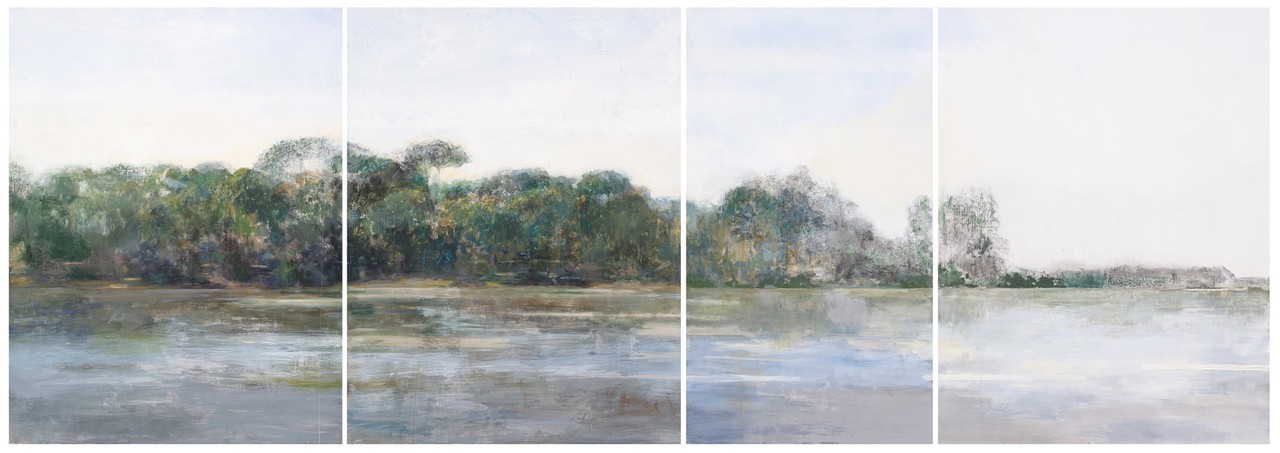Carmen Laffón
Landscape And Locus
09 Oct 2014 - 01 Mar 2015
CARMEN LAFFÓN
Landscape And Locus
9 October 2014 – 1 March 2015
Curator: Juan Bosco Díaz-Urmeneta
Exhibition Session: Landscape: Contemplation, Memory and Activism
This exhibition can be interpreted as a long, slow journey down the River Guadalquivir, from the banks of La Cartuja, when the island was still terra incognita, to Sanlúcar de Barrameda, where it meets the sea. But journeys inevitably change the traveller, and Carmen Laffón's work, grappling with the river's shifting moods, blazes another trail through the very landscape: landscapes that capture the unexpected encounter on La Cartuja, the teeming life on the riverbanks at Bonanza, the gaze that awaits and espies the growing light of dawn over the Coto de Doñana or Doñana Nature Reserve from Sanlúcar, the imminence of the sea at La Jara. We can even make out a third path, laid by the paint itself: measured strokes in Seville, ascendant materiality at Bonanza, colour architecture in the Coto, serene succession of parallel forms at La Jara.
Travel requires an occasional respite, and Laffón found hers beside the river, in the vineyard that surrounds her studio at La Jara. In collusion with the earth, La viña (The Vineyard) offers both shelter and fertility under skies that reflect nature's endless ebb and flow. The vineyard is therefore landscape and locus, and so too are the drawings of the Generalife which contrast the splendour of the vine with the secluded sensuality of the Arab garden.
The locus grows with its inhabitant. Laffón sees her locus take shape in the objects that condense that effort, whether intellectual or physical; in the texts and images that allow us to retrace the poetic universe of the author of Don Quixote, but also in the tools and materials of everyday activity in a blacksmith's shop or the simple impedimenta of the whitewasher representing the age-old culture of lime.
In the end, the exhibition comes full circle: it returns to La Cartuja, to the Priory Garden, as if the artist had transferred her studio to the very site explored, back in 1976, by the drawings that open this show
Landscape And Locus
9 October 2014 – 1 March 2015
Curator: Juan Bosco Díaz-Urmeneta
Exhibition Session: Landscape: Contemplation, Memory and Activism
This exhibition can be interpreted as a long, slow journey down the River Guadalquivir, from the banks of La Cartuja, when the island was still terra incognita, to Sanlúcar de Barrameda, where it meets the sea. But journeys inevitably change the traveller, and Carmen Laffón's work, grappling with the river's shifting moods, blazes another trail through the very landscape: landscapes that capture the unexpected encounter on La Cartuja, the teeming life on the riverbanks at Bonanza, the gaze that awaits and espies the growing light of dawn over the Coto de Doñana or Doñana Nature Reserve from Sanlúcar, the imminence of the sea at La Jara. We can even make out a third path, laid by the paint itself: measured strokes in Seville, ascendant materiality at Bonanza, colour architecture in the Coto, serene succession of parallel forms at La Jara.
Travel requires an occasional respite, and Laffón found hers beside the river, in the vineyard that surrounds her studio at La Jara. In collusion with the earth, La viña (The Vineyard) offers both shelter and fertility under skies that reflect nature's endless ebb and flow. The vineyard is therefore landscape and locus, and so too are the drawings of the Generalife which contrast the splendour of the vine with the secluded sensuality of the Arab garden.
The locus grows with its inhabitant. Laffón sees her locus take shape in the objects that condense that effort, whether intellectual or physical; in the texts and images that allow us to retrace the poetic universe of the author of Don Quixote, but also in the tools and materials of everyday activity in a blacksmith's shop or the simple impedimenta of the whitewasher representing the age-old culture of lime.
In the end, the exhibition comes full circle: it returns to La Cartuja, to the Priory Garden, as if the artist had transferred her studio to the very site explored, back in 1976, by the drawings that open this show

